Start planning your dream Tanzania safari.
Speak with one of our safari experts today.

Alistair
Travel Expert

Tanzania is a culturally diverse country, steeped in history and blessed with breath-taking scenery. From the snow-capped peak of Africa’s highest mountain, Kilimanjaro, to the continent’s second largest lake, Lake Victoria, Tanzania is awe inspiring.
However, your desire to visit Tanzania will likely be partly, if not entirely, to enjoy a wildlife safari; for which the country’s numerous protected areas are renowned. When people talk about a safari to Tanzania, the Serengeti is usually the first word on their lips.
A quarter of Tanzania’s almost 950,000 square kilometres is comprised of national parks and game reserves. If you’ve done your research, you may have considered the common dilemma of whether to visit the country’s northern or southern safari circuit. Let’s not beat around the bush, the south richly rewards those that venture there, but the north’s national parks receive more visitors each year for very good reasons. Top amongst them is the Serengeti, the northern circuit’s jewel in the crown. Its vast grassland plains, teeming with wildlife, stretch as far as the eye can see and feature in many a dramatic television documentary. Here are just a few of the highlights that make the Serengeti so special:
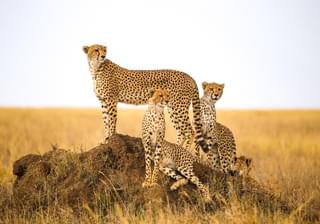
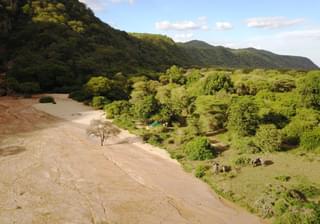
A personal favourite of mine is our Serengeti Family Adventure Safari. It has the Serengeti as its primary focus and the highlight of your trip, but you also experience some of the other exceptional protected areas that comprise Tanzania’s northern safari circuit en route - very worthwhile if time permits. This creates a rounded itinerary, during which you will enjoy an exceptional variety of wildlife, scenery and unique activities.
It can easily be tailored to suit a couple, providing you with your own private guide or a little more exclusivity if you wish, making it perfect for adventurous honeymooners.
Highlights
12 days from £2,509pp including domestic flights (based on 2 adults and 2 children travelling). This trip can easily be combined with the Tanzania coast and Zanzibar for a few days relaxation at the end.


There are two main factors that will influence your decision of when to visit the Serengeti – the weather and the wildlife, or more specifically the wildebeest migration. The following summary hopefully provides a useful overview to make this decision a little easier.
For most people, the choice of north or south is largely dependent on the time of year and hence the migrating herds of wildebeest, zebra and other antelope.

If you are seeking the drama of a river crossing, you will want to be in the north between July and October. You can also catch the epic crossing of the Grumeti River in the western corridor, as the journey heads northward. However, timing can be a little more critical whereas in the north of the Serengeti, there are many more crossings over a longer period, as the herds cross back and forth to the Masai Mara, drawn by the greener grasses and distant clouds. Therefore, your chances of catching this spectacle are a little better here.
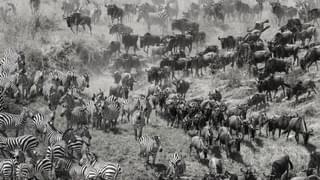
If the joy of new life appeals more, then the south is where you want to be, as the wildebeest calving season takes place there between January and February. The nursery plains of the southern Serengeti are then grazed by the weaning animals for a few more weeks, building their strength before they begin the trek north. Be prepared for the circle of life though, as this time of birth is also a time of opportunity for the predators.
It’s worth mentioning at this point that the magic of the Serengeti and its phenomenal nature - it is not solely about the migration. All the animals of these grassy plains do not simply up sticks, leaving no creature behind. There is resident wildlife that stays in an area permanently, which includes many of the larger mammal species, such as lion, leopard, elephant, cheetah, rhino and buffalo.
Areas like Ndutu and Seronera, with have water sources year-round are renowned for their predator concentrations. In addition, many of the diverse antelope species, for example topi, Grant’s and Thomson’s gazelles, as well as some smaller, but equally special animals.

The Ngorongoro Conservation Area (NCA), although a separate protected area of more than 8,200 square kilometres, it is contiguous with the Serengeti National Park, so wildlife, including the migration, can move freely between the two. The Ndutu region, where wildebeest calving takes place, is often broadly described as the southern Serengeti, but is officially within the NCA. Travelling to the Serengeti by road from Arusha you enter and drive through the NCA, which is another reason that the two are so strongly associated.
Within the NCA is the Ngorongoro Crater itself. This remarkable sunken caldera is one of the most impressive geological features in Africa, measuring up to 19 km in diameter. It boasts a wide variety of habitats, from long and short grass plains, gently rolling hills and woodlands to marshes, soda lakes, freshwater springs and lakes. These are inhabited by equally diverse wildlife, including lions, leopards, cheetahs, hyenas, elephants, hippos and rhinos, as well as a vast array of birdlife.
Unsurprisingly this incredible natural wonder does attract the crowds. Therefore, if you plan to explore the crater floor, as part of your safari, it’s advisable to get an early start and be one of the first vehicles at the descent road gate when it opens. You also have a better chance of catching the predators whilst they are still active by doing so.
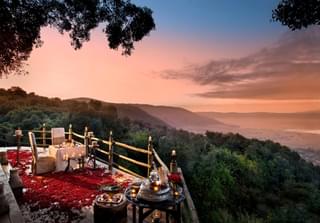
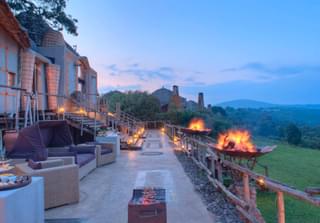
For most visitors to the Serengeti a safari consists of morning and afternoon, or full day, 4x4 game drives in a specially converted Toyota Land Cruiser or Land Rover Defender. These vehicles are designed to maximise wildlife viewing in the parks and comfort on the roads in-between. They have special features that include window seats for all passengers, a pop-up roof, allowing you to stand and enjoy an unobstructed view at sightings, and usually seat up to seven guests, plus your driver-guide. Game drives are a great way to cover a large distance and hence area in a relatively short amount of time, increasing your chances of sightings. The animals have also become quite accustomed to the vehicles, allowing you to safely get quite close to them.
Whilst there are advantages to game drives for spotting the larger wildlife, I would highly recommend at least a couple of nights’ stay at a walking safari camp in the Serengeti. The grass plains offer gentle terrain to set out on foot and the walking tends to be at a relaxed pace, so you don’t need to be super fit to enjoy it. Leaving the noise and bubble of your vehicle opens up a whole new world and elevates your senses. Accompanied by a highly qualified professional guide you will discover nature that you would have rushed past obliviously in your vehicle and feel more connected to this incredible ecosystem.
Another unique perspective on the expansive grasslands of the Serengeti is drifting over the plains in a hot air balloon. You will rise early to enjoy this unforgettable activity, so that your flight may take off at sunrise. The soft morning light delivers warm colours, as you truly appreciate the immensity and beauty of the landscape. Your flight lasts about 60 minutes and you will be treated to a champagne breakfast on landing. It is not cheap, but it’s an experience that you will cherish for a lifetime.
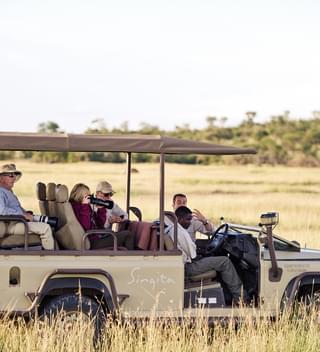
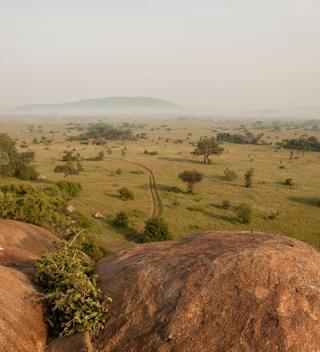
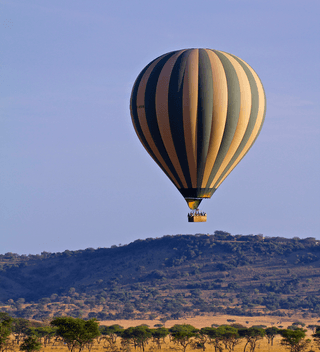
The entry point to Tanzania’s northern safari circuit is Kilimanjaro International Airport (JRO), located between the towns of Moshi and Arusha. International airlines operating to JRO include KLM, Emirates, British Airways and Ethiopian Airlines.
From here, the Serengeti is easy to access by road or air - your choice will be determined by your budget and itinerary, for example whether you are visiting other National Parks or destinations before or after your Serengeti safari.
You can travel by road from Arusha, as part of your private 4x4 safari itinerary, with your own professional driver-guide. This option is popular if you wish to visit a couple of other parks, such as Tarangire, Lake Manyara or Ngorongoro en route. To drive directly the journey is about 325km and takes approximately 8 hours, excluding stops, so it’s advisable to break the journey with at least 1 overnight stay.
Alternatively, you can take a short light aircraft flight from Arusha (ARK) or JRO to one of the seven airstrips situated across the Serengeti. These flights vary in duration from 1 to 5 hours, depending on the airstrip you are flying to and the number of stops along the way for other passengers to board or disembark. Flights are operated by local airlines, including Coastal Aviation and Regional Air. You will be met at the airstrip by your guide.
It’s common to travel by overland safari one way and then fly back to Arusha or your onward destination to save time, particularly if your safari ends right up in the north of the Serengeti.
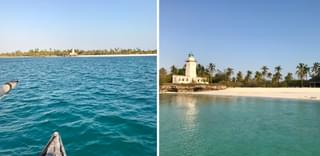
As suggested in the recommended itinerary, there are many other parks in Tanzania that you may include in your itinerary. You may also like to combine your Serengeti safari with another destination further afield, so here are a few ideas to offer some inspiration:
The Serengeti is an unrivalled safari destination for your first safari or connoisseurs alike. Whilst this guide has hopefully given you a little insight to help with planning your trip, you’ve probably realised, there are lots of factors to take into consideration including budget, accommodation style, time of year, the migration, and other parks or destinations that you may wish to visit before or afterwards. To plan your dream Tanzania safari holiday, please get in contact with one of our experts on 01768 603 715 who would love to help you.
Speak with one of our safari experts today.

Travel Expert